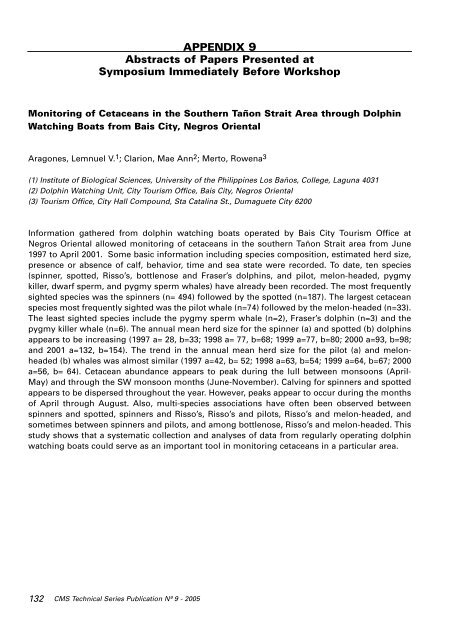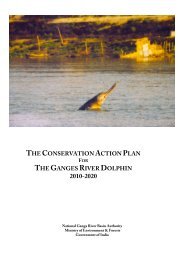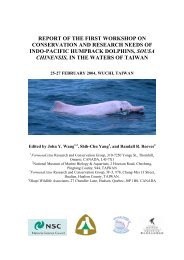CountryFacilityOpenedAnimals <strong>and</strong> DatesHeld as <str<strong>on</strong>g>of</str<strong>on</strong>g> 1OriginSource <str<strong>on</strong>g>of</str<strong>on</strong>g> Informati<strong>on</strong>;ReceivedSep ‘02Comments<str<strong>on</strong>g>Sec<strong>on</strong>d</str<strong>on</strong>g> <str<strong>on</strong>g>Workshop</str<strong>on</strong>g> <strong>on</strong> <str<strong>on</strong>g>the</str<strong>on</strong>g> <strong>Biology</strong> <strong>and</strong> C<strong>on</strong>servati<strong>on</strong> <str<strong>on</strong>g>of</str<strong>on</strong>g> Small Cetaceans <strong>and</strong> Dug<strong>on</strong>gs <str<strong>on</strong>g>of</str<strong>on</strong>g> SE Asia 131232425262728293031323334ChinaChinaInd<strong>on</strong>esiaInd<strong>on</strong>esiaInd<strong>on</strong>esiaMyanmarPhilippinesSingaporeThail<strong>and</strong>Thail<strong>and</strong>VietnamVietnamNatural Museum <str<strong>on</strong>g>of</str<strong>on</strong>g> Marine<strong>Biology</strong> <strong>and</strong> Aquarium, TaiwanOcean World (aka KeelungAquarium), Taipei County,TaiwanDolphin Lodge, Batam Isl<strong>and</strong>(near Singapore)Jaya Ancol Aquarium, JakartaSea World Ind<strong>on</strong>esia, JakartaJim Styers Dolphin World,Sal<strong>on</strong>e Isl<strong>and</strong>, Myanmar /Thail<strong>and</strong> borderOcean Adventures Park, SubicBay, Luz<strong>on</strong>Underwater Singapore World,Sentosa Isl<strong>and</strong>Oasis Seaworld, ChantaburiProvinceSafari World, Minburi, BangkokCultural House <str<strong>on</strong>g>of</str<strong>on</strong>g> 5 th District, HoChi Minh CitySuoi Mo Park, Thu Duc District,Ho Chi Minh City20001988?20011974?20022001before 1999199019882002?2002?6 D. leucas (2002)16-17 T. aduncus (date?)>1 T. truncatus (date?)>1 P. crassidens (date?)14Tursiops sp. (2001)T. aduncus (no.?, 1975-82)12 T. aduncus (1997)2 D. dug<strong>on</strong> (2001)1 D. dug<strong>on</strong> (2000)3 Tursiops sp. (2002)6 P. crassidens (2001)1 D. dug<strong>on</strong> (1998)6 S. chinensis (1999)13 O. brevirostris (2002)8 S. chinensis (date?)14 Tursiops sp. (date?)4 D. leucas (2002)3 T. truncatus (1999)>1 Tursiops sp. (date?)516-171114??213415138?421RussiaDrive fishery,taiwanInd<strong>on</strong>esiaInd<strong>on</strong>esiaInd<strong>on</strong>esiaMyanmarDrive fishery,JapanSingaporeThail<strong>and</strong>Thail<strong>and</strong> (<strong>and</strong>maybeCambodia)Ind<strong>on</strong>esiaRussiaRussiaRussiaWangWangBeasleyTas’an <strong>and</strong> Lea<str<strong>on</strong>g>the</str<strong>on</strong>g>rwood 1984R. Kinoshita, pers. comm.BeasleyL. Tjhin, pers. comm.Beasley; SmithC<strong>on</strong>cepci<strong>on</strong>Lin 1999BeasleyM. Rajit, CITES Thail<strong>and</strong>,pers. comm.BuiBui35VietnamAu Lac Parak, Tuan Chau Isl<strong>and</strong>,Ha L<strong>on</strong>g City, Haiph<strong>on</strong>g20012 D. leucas (1999)2RussiaBui
APPENDIX 9Abstracts <str<strong>on</strong>g>of</str<strong>on</strong>g> Papers Presented atSymposium Immediately Before <str<strong>on</strong>g>Workshop</str<strong>on</strong>g>M<strong>on</strong>itoring <str<strong>on</strong>g>of</str<strong>on</strong>g> Cetaceans in <str<strong>on</strong>g>the</str<strong>on</strong>g> Sou<str<strong>on</strong>g>the</str<strong>on</strong>g>rn Tañ<strong>on</strong> Strait Area through DolphinWatching Boats from Bais City, Negros OrientalArag<strong>on</strong>es, Lemnuel V. 1 ; Clari<strong>on</strong>, Mae Ann 2 ; Merto, Rowena 3(1) Institute <str<strong>on</strong>g>of</str<strong>on</strong>g> Biological Sciences, University <str<strong>on</strong>g>of</str<strong>on</strong>g> <str<strong>on</strong>g>the</str<strong>on</strong>g> Philippines Los Baños, College, Laguna 4031(2) Dolphin Watching Unit, City Tourism Office, Bais City, Negros Oriental(3) Tourism Office, City Hall Compound, Sta Catalina St., Dumaguete City 6200Informati<strong>on</strong> ga<str<strong>on</strong>g>the</str<strong>on</strong>g>red from dolphin watching boats operated by Bais City Tourism Office atNegros Oriental allowed m<strong>on</strong>itoring <str<strong>on</strong>g>of</str<strong>on</strong>g> cetaceans in <str<strong>on</strong>g>the</str<strong>on</strong>g> sou<str<strong>on</strong>g>the</str<strong>on</strong>g>rn Tañ<strong>on</strong> Strait area from June1997 to April 2001. Some basic informati<strong>on</strong> including species compositi<strong>on</strong>, estimated herd size,presence or absence <str<strong>on</strong>g>of</str<strong>on</strong>g> calf, behavior, time <strong>and</strong> sea state were recorded. To date, ten species(spinner, spotted, Risso’s, bottlenose <strong>and</strong> Fraser’s dolphins, <strong>and</strong> pilot, mel<strong>on</strong>-headed, pygmykiller, dwarf sperm, <strong>and</strong> pygmy sperm whales) have already been recorded. <strong>The</strong> most frequentlysighted species was <str<strong>on</strong>g>the</str<strong>on</strong>g> spinners (n= 494) followed by <str<strong>on</strong>g>the</str<strong>on</strong>g> spotted (n=187). <strong>The</strong> largest cetaceanspecies most frequently sighted was <str<strong>on</strong>g>the</str<strong>on</strong>g> pilot whale (n=74) followed by <str<strong>on</strong>g>the</str<strong>on</strong>g> mel<strong>on</strong>-headed (n=33).<strong>The</strong> least sighted species include <str<strong>on</strong>g>the</str<strong>on</strong>g> pygmy sperm whale (n=2), Fraser’s dolphin (n=3) <strong>and</strong> <str<strong>on</strong>g>the</str<strong>on</strong>g>pygmy killer whale (n=6). <strong>The</strong> annual mean herd size for <str<strong>on</strong>g>the</str<strong>on</strong>g> spinner (a) <strong>and</strong> spotted (b) dolphinsappears to be increasing (1997 a= 28, b=33; 1998 a= 77, b=68; 1999 a=77, b=80; 2000 a=93, b=98;<strong>and</strong> 2001 a=132, b=154). <strong>The</strong> trend in <str<strong>on</strong>g>the</str<strong>on</strong>g> annual mean herd size for <str<strong>on</strong>g>the</str<strong>on</strong>g> pilot (a) <strong>and</strong> mel<strong>on</strong>headed(b) whales was almost similar (1997 a=42, b= 52; 1998 a=63, b=54; 1999 a=64, b=67; 2000a=56, b= 64). Cetacean abundance appears to peak during <str<strong>on</strong>g>the</str<strong>on</strong>g> lull between m<strong>on</strong>so<strong>on</strong>s (April-May) <strong>and</strong> through <str<strong>on</strong>g>the</str<strong>on</strong>g> SW m<strong>on</strong>so<strong>on</strong> m<strong>on</strong>ths (June-November). Calving for spinners <strong>and</strong> spottedappears to be dispersed throughout <str<strong>on</strong>g>the</str<strong>on</strong>g> year. However, peaks appear to occur during <str<strong>on</strong>g>the</str<strong>on</strong>g> m<strong>on</strong>ths<str<strong>on</strong>g>of</str<strong>on</strong>g> April through August. Also, multi-species associati<strong>on</strong>s have <str<strong>on</strong>g>of</str<strong>on</strong>g>ten been observed betweenspinners <strong>and</strong> spotted, spinners <strong>and</strong> Risso’s, Risso’s <strong>and</strong> pilots, Risso’s <strong>and</strong> mel<strong>on</strong>-headed, <strong>and</strong>sometimes between spinners <strong>and</strong> pilots, <strong>and</strong> am<strong>on</strong>g bottlenose, Risso’s <strong>and</strong> mel<strong>on</strong>-headed. Thisstudy shows that a systematic collecti<strong>on</strong> <strong>and</strong> analyses <str<strong>on</strong>g>of</str<strong>on</strong>g> data from regularly operating dolphinwatching boats could serve as an important tool in m<strong>on</strong>itoring cetaceans in a particular area.132 CMS Technical Series Publicati<strong>on</strong> Nº 9 - 2005
- Page 1 and 2:
CMS Technical Series Publication N
- Page 3 and 4:
Published by the U
- Page 5 and 6:
TABLE OF CONTENTSpage1. Preliminari
- Page 7 and 8:
AppendicesAppendix 1 - List <strong
- Page 9 and 10:
8 CMS Technical Series Publication
- Page 11 and 12:
10 CMS Technical Series Publication
- Page 13 and 14:
The cetacean species reviewed inclu
- Page 15 and 16:
Table 1. Major commercial Commonwea
- Page 17 and 18:
(2) State Legislation.In state wate
- Page 19 and 20:
(2) Identification of</stro
- Page 21 and 22:
Coastal speciesThe most frequently
- Page 23 and 24:
Coastal speciesThere are currently
- Page 25 and 26:
and Guangxi Provinces (Yang et al.
- Page 27 and 28:
Table 3. Records of</strong
- Page 29 and 30:
can be viewed as the</stron
- Page 31 and 32:
Workshop participa
- Page 33 and 34:
ioaccumulation have not yet been ex
- Page 35 and 36:
of fishermen who h
- Page 37 and 38:
are supplied to scholars and organi
- Page 39 and 40:
threats. Many marine mammal populat
- Page 42:
waters or recognize important inter
- Page 47 and 48:
James Cook University (Queensland,
- Page 49 and 50:
the last ten years
- Page 51 and 52:
proactive in engaging more staff an
- Page 53 and 54:
of SE Asia. Two sp
- Page 55 and 56:
San Francisco (Negros Oriental); Li
- Page 57 and 58:
Legal status and present management
- Page 59 and 60:
within 15 kilometers from t
- Page 61 and 62:
US, has actively participated in ce
- Page 63 and 64:
the project was su
- Page 65 and 66:
Recently, the camp
- Page 67 and 68:
Mekong River downstream of<
- Page 69 and 70:
porpoises in tropical waters <stron
- Page 71 and 72:
species in the Ind
- Page 73 and 74:
Population/stock structureNo new in
- Page 75 and 76:
Needs for additional researchStock
- Page 77 and 78:
waters of SE Asia,
- Page 79 and 80:
caused mortality is certainly large
- Page 81 and 82: Needs for additional researchProper
- Page 83 and 84: from SE Asia, it is known to occur
- Page 85 and 86: 3.1.7 AustraliaDugongs occur all al
- Page 87 and 88: Table 8. Conservation objectives id
- Page 89 and 90: 3) Monitoring and assessment <stron
- Page 91 and 92: Table 10. Outline of</stron
- Page 93 and 94: The group agreed that this set <str
- Page 95 and 96: 6. SUMMARY AND CONCLUSIONSThe works
- Page 97 and 98: 96 CMS Technical Series Publication
- Page 99 and 100: Bank, E. 1931. A popular account <s
- Page 101 and 102: Dalebout, M. L., J. G. Mead, C. Sco
- Page 103 and 104: Jaaman, S. A., E. Tangon, I. Isnain
- Page 105 and 106: Lin, Y.-J. 1997. Mitochondrial DNA
- Page 107 and 108: Smith, B.D., T. A. Jefferson, D. Ho
- Page 109 and 110: Yang, W.-C. 2000. Morbillivirus inf
- Page 111 and 112: CHOU Lien-SiangDepartment o
- Page 113 and 114: Brian D. SMITHWildlife Conservation
- Page 115 and 116: APPENDIX 3Agenda1. Preliminaries2.
- Page 117 and 118: Doc. 22 Dugong conservation activit
- Page 119 and 120: AreaDatesSurveyTypeEffortSpeciesNo.
- Page 121 and 122: AreaDatesSurveyTypeEffortSpeciesNo.
- Page 123 and 124: AreaDatesSurveyTypeEffortSpeciesNo.
- Page 125 and 126: Phase ofActionPlan
- Page 127 and 128: [Small cetaceans are defined to inc
- Page 129 and 130: f) recognizing that by-catch in fis
- Page 131: 130 CMS Technical Series Publicatio
- Page 135 and 136: The (IUCN Critically Endangered) Du
- Page 137 and 138: Status of
- Page 139 and 140: Cetacean Habitats in the</s
- Page 141 and 142: Conservation of <s
- Page 143 and 144: Summary of Current
- Page 145 and 146: Indonesia’s Cetacean Migration Co
- Page 147 and 148: Conservation Effort to Protect <str
- Page 149 and 150: The Status of <str
- Page 151 and 152: Can the Developing
- Page 153 and 154: Status and Conservation of<
- Page 155 and 156: Legal Hunting of C
- Page 157 and 158: Indo-Pacific Bottlenose Dolphins (T
- Page 159 and 160: Feasibility Study of</stron
- Page 161 and 162: Songs of a Humpbac





